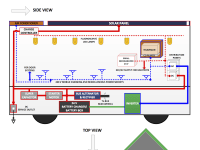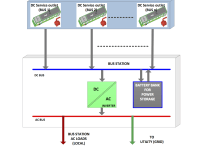The proposed solution focuses on using a combination of solar energy and super-capacitors to reduce the dependency of large vehicles (e.g.: Buses) on conventional energy and in parallel enhance battery life by preventing deep discharge cycles.
Although a lot of advancements are happening in the direction of employing clean energy in the automotive sector (e.g.: Electric vehicles), the implementation has been minimal, mainly due to high initial costs, acceptance issues and technological challenges. The option of replacing the existing huge vehicle base with the renewable technology is thus, unthinkable.
The solution primarily focuses on harnessing solar energy via photovoltaic (PV) panels installed on the rooftop of the vehicle and using the produced energy to supply the auxiliary loads of the vehicle (e.g: lights, doors, TV/DVD/Music system, refrigerator, heating systems in food carts, cooling in food transport containers etc) thus reducing the energy intake from the fuel which runs the alternator which is driven by a prime mover, the conventional internal combustion engine as in our case.
The second part of the solution focuses on using super capacitors which are charged to full capacity by PV panels on a priority basis to supply the required peak power during vehicle start-up, thus avoiding deep discharges of the battery. This could significantly enhance the useful lifetime of the battery. (Lead acid batteries being the chunk of the batteries used around the world and with its well-known negative impact on the environment, extension of the battery life can go a long way in making the world sustainable.)
The proposed solution can be implemented as a retrofit, possibly in the form of a modular unit. In the initial phase, the solution may be implemented in intercity routes (Primarily concentrating on the Indian scenario) where large stretches of highway are continuously exposed to the sun. The market potential looks promising as a minimal investment and maximum utilization is seen and without disturbing the existing vehicle setup. However, the major investment is in the direction of the solar panels and government participation goes a long way in deciding the market potential.
The working principle is quite simple with a main controller optimally managing the various functional cases of the setup.
• A completely charged super capacitor supplies initial energy for starting the vehicle.
• During vehicular movement, solar energy is continuously harvested with the following priorities-charge super capacitor, charge the battery and then supply auxiliary loads.
• Based on the availability of the sun the main controller switches the operating states between battery, solar and the corresponding local/auxiliary loads.
• Once the infrastructure is well developed, advanced functionalities like grid integration, local micro-grid development can be integrated.
The indigenous solution is seen to be low in costs and easy in implementation. Source-ability and manufacture-ability are not seen to be a challenge. This is seen as a quick and efficient means to contribute to the sustainability keeping in view of falling price of PV panels, thus resulting in an innovative solution for the near future.
Like this entry?
-
About the Entrant
- Name:Sujay Ramalingam
- Type of entry:teamTeam members:Sujay Ramalingam Raghavendra Ramachandra Barkur Aravind Ponnathapura Manjunatha
- Software used for this entry:MS Visio
- Patent status:none








